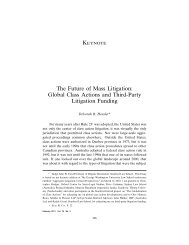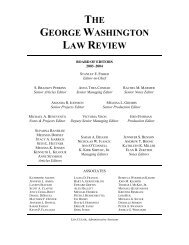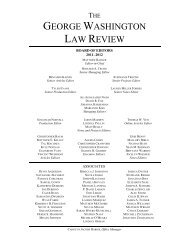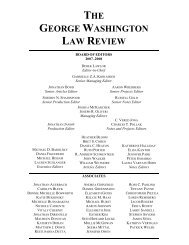View PDF - The George Washington Law Review
View PDF - The George Washington Law Review
View PDF - The George Washington Law Review
Create successful ePaper yourself
Turn your PDF publications into a flip-book with our unique Google optimized e-Paper software.
888 <strong>The</strong> <strong>George</strong> <strong>Washington</strong> <strong>Law</strong> <strong>Review</strong> [Vol. 78:870<br />
Penn Central altogether and resort to the per se rules of Lucas and<br />
Loretto. If the Court had to “eat crow” in Lingle by admitting that it<br />
wrongly confused due process and takings law, 109 perhaps the Court<br />
should again be prepared to “eat crow” by admitting that the balancing<br />
test from Penn Central is fundamentally flawed. Considering that<br />
Lingle has severely weakened Penn Central, there would be no better<br />
time to abandon this test. 110<br />
John Echeverria explains that abandoning Penn Central exclusively<br />
in favor of applying the per se rules of Lucas and Loretto would<br />
leave regulatory takings doctrine “[e]xactly where it should be, with a<br />
set of relatively well defined rules for identifying regulations that are<br />
legitimate takings.” 111 A move to these bright-line rules would have<br />
many beneficial effects. Perhaps most important, Lucas and Loretto<br />
offer far more predictability than the vague ad hoc balancing test that<br />
has evolved since Penn Central. Additionally, the use of predictable<br />
per se rules would necessarily leave less room for subjectivity, and,<br />
thus, the Court would not be in the position to act as a superlegislature.<br />
112 Lastly, staying true to Justice O’Connor’s opinion in Lingle, a<br />
taking under Lucas or Loretto would be “functionally equivalent to<br />
the classic taking in which government directly appropriates private<br />
property or ousts the owner from his domain.” 113<br />
Of course, the adoption of a regulatory takings doctrine embracing<br />
only the per se rules of Lucas and Loretto would not be without its<br />
faults, because it would substantially underprotect property rights.<br />
Most regulations, even the most intrusive, do not rid the property of<br />
all economic value as required by Lucas 114 or cause a permanent physical<br />
occupation as required by Loretto. 115 Property owners would have<br />
nowhere to turn for the relief to which they should be constitutionally<br />
109 Jacobs, supra note 61, at 486.<br />
110 This is especially true if the Penn Central test is viewed as containing only two factors.<br />
See supra note 10 (explaining an interpretation of the Penn Central test as having only two factors).<br />
If Lingle erased the “character of the governmental action” factor, then the Penn Central<br />
test would only include one factor: the economic impact of the regulation in light of the claimant’s<br />
distinct investment-backed expectations.<br />
111 Echeverria, supra note 25, at 10.<br />
112 See id. at 11. Echeverria argues that use of the per se rules of Lucas and Loretto “makes<br />
takings law far more predictable and less susceptible to variation based on the personal predilections<br />
of the particular judge hearing the case. Determining whether a regulation has eliminated<br />
all (or nearly all) economic value of a property presents a relatively simple and straightforward<br />
issue.” Id.<br />
113 Lingle v. Chevron U.S.A. Inc., 544 U.S. 528, 539 (2005).<br />
114 See Lucas v. S.C. Coastal Council, 505 U.S. 1003, 1015 (1992).<br />
115 See Loretto v. Teleprompter Manhattan CATV Corp., 458 U.S. 419, 426 (1982).









